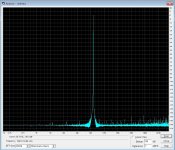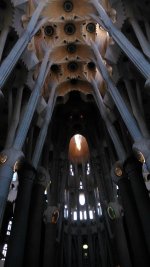All the audio related software I have uses double precision floating point math (64bit).
The cheapo-gear I am thinking of allows a lot of the basic mixing/storing/bouncing et al done in hardware which a "musician" can afford or garage band or teenager in their room or even a studio of minimal sorts. Such items are very popular; such as --- TASCAM DP-325D. Or larger versions/other brands. For a price less than a computer to run Pro Tools. The TASCAM is a 32-track Digital PortaStudio and sells for $500.
THx-RNMarsh
The cheapo-gear I am thinking of allows a lot of the basic mixing/storing/bouncing et al done in hardware which a "musician" can afford or garage band or teenager in their room or even a studio of minimal sorts. Such items are very popular; such as --- TASCAM DP-325D. Or larger versions/other brands. For a price less than a computer to run Pro Tools. The TASCAM is a 32-track Digital PortaStudio and sells for $500.
THx-RNMarsh
I'm not that familiar with that unit, BTW the $99 miniDSP is 56bit. I don't think anyone uses low word size integer DSP's for audio anymore. You need to look at the internal workings to determine the bit depth of the math. Floating point DSP's are dirt cheap as the miniDSP line shows.
BTW my software is all free.
The TASCAM is really PnP operation for the non-computer/tech geek and just wants to create on the fly or record a band etc. I think now the DSP has taken over many tasks, as they are used liberally in the inexpensive Behringer gear I own. Never-the-less, it cant be assumed everywhere and even low cost DSP can be abused.... there are limits and musicians seem to find those limits easily. Dithering at every step of the way is probably needed more than is done as well.
[I own ProTools and Cubase, SONAR and several others. They sure are some powerful software.... with more features than you can think of all by yourself. But only recently I had the cpu power and SSD I felt makes those programs fast and furious].
THx-RNMarsh
[I own ProTools and Cubase, SONAR and several others. They sure are some powerful software.... with more features than you can think of all by yourself. But only recently I had the cpu power and SSD I felt makes those programs fast and furious].
THx-RNMarsh
Last edited:
BTW the $99 miniDSP is 56bit. I don't think anyone uses low word size integer DSP's for audio anymore. You need to look at the internal workings to determine the bit depth of the math. Floating point DSP's are dirt cheap as the miniDSP line shows.
For the 2x4 miniDSP (with the ADAU1701):
The input (ADC out) and output (DAC input) word lengths of the DSP core are 24 bits.
Four extra headroom bits are used in the processor to allow for internal gain. (so the DSP core is 28bits)
The accumulator used in the signal processing is 56-bit and uses double-precision arithmetic data (50MIPS)
George
I spent an afternoon wondering around the Sagrida Familia. Incredible building. I think it will be finished in about 15 years - 140 years since they broke ground. I just love Barcelona - awesome city.
All the audio related software I have uses double precision floating point math (64bit).
Cool Edit is 32bit.
For the 2x4 miniDSP (with the ADAU1701):
The input (ADC out) and output (DAC input) word lengths of the DSP core are 24 bits.
Four extra headroom bits are used in the processor to allow for internal gain. (so the DSP core is 28bits)
The accumulator used in the signal processing is 56-bit and uses double-precision arithmetic data (50MIPS)
George
All you need is enough headroom at each stage to avoid needing to know all the dynamic range tricks that early DSP app notes stressed. Maybe the cheapest miniDSP is not the best example, and the miniSHARK is not that much more. I realize their app note giving filter coefficients to 10 or 12 decimal places seems a little ambitious.
I will be looking at its performance in detail for an upcoming article.
I don't use that for any actual computations, sorry I wasn't clear. Though 32bit float still has -160dB or so noise floor in reality the difference is rather trivial when any noise enters the picture.Cool Edit is 32bit.
Last edited:
Though 32bit float still has -160dB or so noise floor in reality the difference is rather trivial when any noise enters the picture.
How is -160dB noise floor possible when 32bit float has 24bit mantissa?
I don't use that for any actual computations, sorry I wasn't clear. Though 32bit float still has -160dB or so noise floor in reality the difference is rather trivial when any noise enters the picture.
Thanks for clarification.
Have use explored Farina's Kirkeby Inverse plugin for CE?
How is -160dB noise floor possible when 32bit float has 24bit mantissa?
We're talking about two different things. This is a 32 bit sine wave at about 1Hz (96000/65536) per FFT bin. The spurs are actually systematic errors in the standard math function for sine.
Attachments
Happy Birthday John Curl
Happy Birthday John Curl (2/13)! Hope you have a great birthday and get lots of well wishes. 😀
Happy Birthday John Curl (2/13)! Hope you have a great birthday and get lots of well wishes. 😀
Thanks for clarification.
Have use explored Farina's Kirkeby Inverse plugin for CE?
No, frankly I'm a cheapskate and don't buy any of this stuff. that which interests me I redo from the basic theory when it's presented in full. As another point I'm not that interested in the whole room equalization problem.
Angelo is a great resource and is perfect for those who want to plug and play.
We're talking about two different things.
Yes, I took it by 'noise floor' you meant in the audible band.
This is a 32 bit sine wave at about 1Hz (96000/65536) per FFT bin. The spurs are actually systematic errors in the standard math function for sine.
So there the noise looks to be around -170dB in a 1.5Hz band which integrates out to -125dB or about 21bits.
I have numerous kids and all of them are when allowed plugged in to music 24/7, they love their music, they love it even more on our decent systems, but will listen to it on a crystal radio if it is all they have...
Yeah, but can they unconsciously tap their feet when listening to the crystal radio?
Yeah, but can they unconsciously tap their feet when listening to the crystal radio?
If a piece of music makes me want to tap my feet when listening to it on a nice system, I'm no less inclined to tap my feet when I listen to it on this:
An externally hosted image should be here but it was not working when we last tested it.
se
I spent an afternoon wondering around the Sagrida Familia. Incredible building. I think it will be finished in about 15 years - 140 years since they broke ground. I just love Barcelona - awesome city.
Next time, do not forget to get in Sagrada Família. You will have to wait a queue for more than one hour, but the result is worth the time.
Attachments
Yes, I took it by 'noise floor' you meant in the audible band.
So there the noise looks to be around -170dB in a 1.5Hz band which integrates out to -125dB or about 21bits.
Some other bits of information regarding our beloved analog........ early 78 rpm records had a dynamic range of 30-40dB = 5-6 bits.
Cassette tape was 6 bits typical..... but pro tape and machine and Dolby was up to 70db. Same as vinyl on a really good day. Vinyl LP dynamic range runs around 60-70dB or 11 bits worth of resolution.
The best pro Tape machines were from 60dB all the way up to 110dB if you allowed 3% THD.
With a 120dB dynamic hearing range, it doesnt take very many mixes and combining channels, layering etc from digital recording techniques to be within audibility (<100dB dynamic range) unless great care is used in applying digital designs. I suspect many of the digital issues will continue to be on the record side as the equipment now is very complex and feature laden. Dithering every step of the way will allow the dynamic range to be kept very high and processing with 32-64 floating bits. If we do this right, it can come very much closer to perfect sound forever than we have ever experienced before.
That is your challenge today. "Now go do the right thing" as Dr Laura would say.
THx-RNMarsh
Last edited:
Happy Birthday John Curl (2/13)! Hope you have a great birthday and get lots of well wishes. 😀
Yes JC.... Happy B-Day..... and glad you are still on this side with us. Every day above ground is a good day.
-RM
Last edited:
Some other bits of information regarding our beloved analog........ early 78 rpm records had a dynamic range of 30-40dB = 5-6 bits.
Cassette tape was 6 bits typical..... but pro tape and machine and Dolby was up to 70db. Same as vinyl on a really good day. Vinyl LP dynamic range runs around 60-70dB or 11 bits worth of resolution.
The best pro Tape machines were from 60dB all the way up to 110dB if you allowed 3% THD.
With a 120dB dynamic hearing range, it doesnt take very many mixes and combining channels, layering etc from digital recording techniques to be within audibility (<100dB dynamic range) unless great care is used in applying digital designs. I suspect many of the digital issues will continue to be on the record side as the equipment now is very complex and feature laden. Dithering every step of the way will allow the dynamic range to be kept very high and processing with 32-64 floating bits. If we do this right, it can come very much closer to perfect sound forever than we have ever experienced before.
That is your challenge today. "Now go do the right thing" as Dr Laura would say.
THx-RNMarsh
What is dither? | EarLevel Engineering
-RM
- Status
- Not open for further replies.
- Home
- Member Areas
- The Lounge
- John Curl's Blowtorch preamplifier part II


